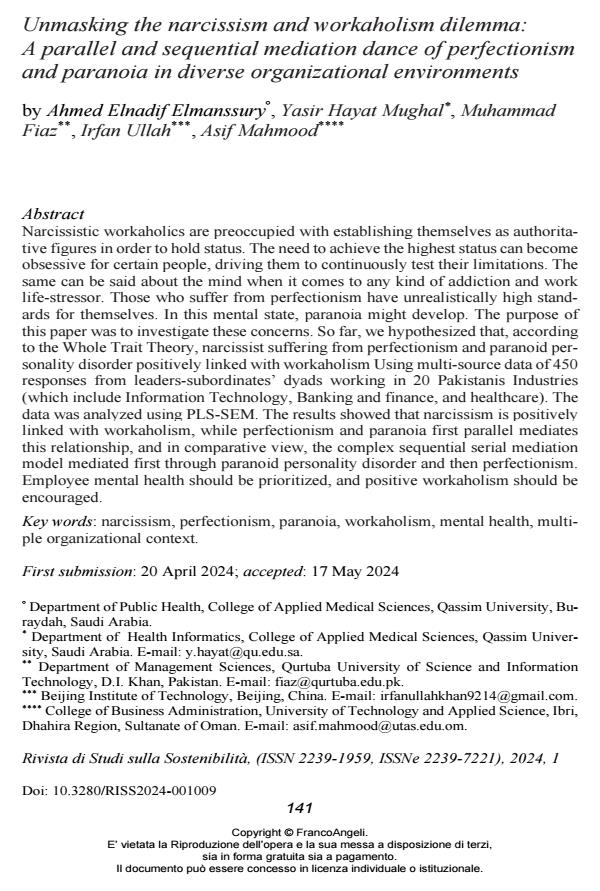Unmasking the narcissism and workaholism dilemma: A parallel and sequential mediation dance of perfectionism and paranoia in diverse organizational environments
Journal title RIVISTA DI STUDI SULLA SOSTENIBILITA'
Author/s Ahmed Elnadif Elmanssury, Yasir Hayat Mughal, Muhammad Fiaz, Irfan Ullah, Asif Mahmood
Publishing Year 2024 Issue 2024/1
Language English Pages 32 P. 141-172 File size 287 KB
DOI 10.3280/RISS2024-001009
DOI is like a bar code for intellectual property: to have more infomation
click here
Below, you can see the article first page
If you want to buy this article in PDF format, you can do it, following the instructions to buy download credits

FrancoAngeli is member of Publishers International Linking Association, Inc (PILA), a not-for-profit association which run the CrossRef service enabling links to and from online scholarly content.
Narcissistic workaholics are preoccupied with establishing themselves as authoritative figures in order to hold status. The need to achieve the highest status can become obsessive for certain people, driving them to continuously test their limitations. The same can be said about the mind when it comes to any kind of addiction and work life-stressor. Those who suffer from perfectionism have unrealistically high standards for themselves. In this mental state, paranoia might develop. The purpose of this paper was to investigate these concerns. So far, we hypothesized that, according to the Whole Trait Theory, narcissist suffering from perfectionism and paranoid personality disorder positively linked with workaholism Using multi-source data of 450 responses from leaders-subordinates’ dyads working in 20 Pakistanis Industries (which include Information Technology, Banking and finance, and healthcare). The data was analyzed using PLS-SEM. The results showed that narcissism is positively linked with workaholism, while perfectionism and paranoia first parallel mediates this relationship, and in comparative view, the complex sequential serial mediation model mediated first through paranoid personality disorder and then perfectionism. Employee mental health should be prioritized, and positive workaholism should be encouraged.
Keywords: narcissism, perfectionism, paranoia, workaholism, mental health, multiple organizational context.
Ahmed Elnadif Elmanssury, Yasir Hayat Mughal, Muhammad Fiaz, Irfan Ullah, Asif Mahmood, Unmasking the narcissism and workaholism dilemma: A parallel and sequential mediation dance of perfectionism and paranoia in diverse organizational environments in "RIVISTA DI STUDI SULLA SOSTENIBILITA'" 1/2024, pp 141-172, DOI: 10.3280/RISS2024-001009